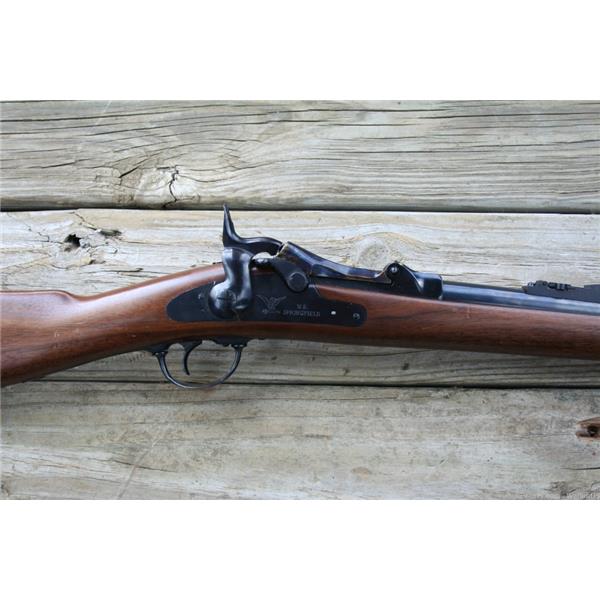
General George Armstrong Custer’s battalion was armed with the carbine version of the Springfield Model 1873 at the Battle of the Little Bighorn, also known as the Battle of the Greasy Grass in June, 25 and 26, 1876.Ĭuster led the unprepared 7th Cavalry based on poor intelligence, bad tactics and hubris against the Native Americans who better were armed with the superior Henry, Spencer and Winchester repeating rifles. The barrel length of the infantry model was 32 5/8 inches and the cavalry carbine had a much reduced 22 inch barrel to permit additional maneuverability while on horseback. This rendered the weapon a second-rate club in battle and not too effective in a gun fight.
#Value of 1873 springfield trapdoor rifle manual#
Shooters discovered almost immediately that the copper would expand upon discharge and repeatedly jam in the breech, requiring manual extraction using a knife edge to pry loose the hot spent shell. The rifle was initially issued with a significant inventory of copper cartridges and this created a major problem. A reduced load (350 grain) was created specifically for cavalry, restricting the muzzle velocity to a more manageable 1100 feet per second for the horsemen. The recoil proved too robust for mounted troops as it tended to unhorse the soldier. The Model 1873 was a very powerful rifle for the era with a muzzle velocity of 1,350 feet per second with a. 50-70 cartridge, though by this point, after five earlier attempts, the design had morphed into a completely new weapon the Model 1873. In the wake of the Civil War the U.S Government had 1.5 million surplus muzzle loading M 1863 percussion rifles and numerous attempts were made to modify these weapons to function with Allin breach loading mechanism. These rifles were named for their hinged breechblock design that opened upward like a trapdoor, allowing shooters access to the chamber and in turn faster, cleaner loading. Allin had made only five versions of the Allin trapdoor design prior to the Model 1873. Consequently, it became necessary to develop weapons that would mitigate the advantage of guerilla warfare tactics, characteristic of these protracted Indian Wars and the brass back east hoped the Model 1873 would provide that leg up for the Army. All of these warring tribes had adapted to a horse centric culture centuries prior and, as such, it became evident to an expanding settlers that Native American riders were the equal if not superior to any mounted soldier in battle.
#Value of 1873 springfield trapdoor rifle full#
The rifle, in both full length and carbine versions, was used in the Great Sioux War of 1876 involving the Lakota, Arapaho and Northern Cheyenne nations, a conflict sometimes referred to as the Black Hills War.

It remained in service for 15 years as an armament mainstay of both cavalry and ground troops and to many, it was known as one of the worst US military weapons ever issued. Cavalry issue in the late 1870s and it was the first breech-loading rifle adopted by the Army. Meet the Model 1873, single shot, Springfield Carbine.


 0 kommentar(er)
0 kommentar(er)
